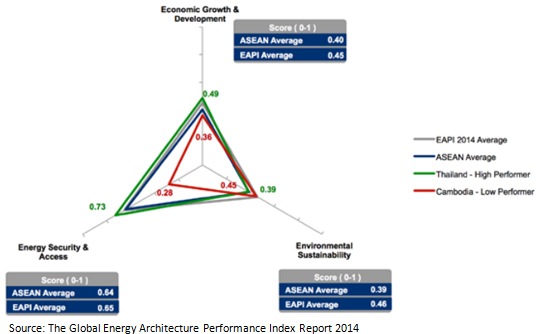World Economic Forum Assesses ASEAN’s Rising Energy Demand
By Shawn Greene
Dec. 26 – The World Economic Forum (WEF) and Accenture have issued the Global Energy Architecture Performance Index Report 2014 which assesses energy systems across countries, and examines how the international community can move towards a future of sustainable energy. The 104-page document assesses economic growth, environmental sustainability, and energy security across 124 countries to determine the most effective energy systems for a sustainable future.
According to the document’s overview of ASEAN’s performance, the region’s rising demand for energy is expected to increase by an additional 80 percent between 2013 and 2035.
“Given the uneven spread of natural resources across the South-East Asian region, integration of energy systems could be instrumental in balancing supply and demand. From an energy perspective, the integration plan includes the roll-out of the integrated ASEAN Power Grid and the development of a Trans-ASEAN Gas Pipeline – initiatives that would greatly benefit the energy security of the region,” the report noted.
Key Challenges
According to the report, the disparate size of ASEAN’s economies creates some key challenge areas that will be exacerbated by the expected increase in energy demand in the region. Analyzing 18 unique factors in their assessment of how countries perform in each facet of their energy architecture, the report ranks the ASEAN nations’ energy capacity on a scale from 0 to 1, with 1 being the highest possible performance on the report index.
In terms of energy intensity, ASEAN countries received an average score of 0.38/1 against the global average of 0.48/1. ASEAN’s most energy-intensive economies of Vietnam, Thailand, Brunei and Indonesia all scored below 0.30/1 on the report scale, highlighting challenges surrounding the intersection of energy intensity with a continued dependence on energy imports and fossil fuels.
Indonesia, Malaysia, the Philippines, Singapore and Thailand received the highest scores in ASEAN regarding economic growth and development due primarily to higher electrification rates and GDP, coupled with overall lower energy intensity. Cambodia, possessing the least developed economy in ASEAN, ranked the lowest regionally with low electrification rates and an over-dependent on imports of fossil fuels.
However, high-producing economics including Singapore, Brunei and Malaysia each continue to receive less than 10 percent of their total energy supply from alternative and nuclear sources. This draws attention to a regional over-dependence upon fossil fuels, and the detrimental impact fossil fuel subsidies have upon investment in low-carbon technologies in nations such as Brunei and Malaysia.
While the phase-out of fossil fuels is being advocated in several ASEAN nations, the International Energy Agency (IEA) estimates that in 2012 subsidies of super gasoline and diesel in the ASEAN region amounted to more than US$51 billion, with the highest price distortion occurring in Brunei, Malaysia, Thailand, Indonesia and Vietnam.
Some noticeable progress towards phasing out these programs is being made in Indonesia, which utilized its subsidy reform process to increase gasoline and diesel prices in June 2013, and in Brunei, Malaysia, Myanmar, Thailand and Vietnam, who have implemented other policies to improve the alignment of their domestic pricing for fuels and energy with global markets.

Towards Energy Security
With the region’s energy demand expected to grow by 80 percent by 2035, energy security is one of the most critical challenges facing ASEAN.
“Although ASEAN has extensive natural resource endowments – notably in Indonesia, Brunei Darussalam and Malaysia – the region’s supple infrastructure is a growing challenge. The IEA estimates that US$1.7 trillion of cumulative investment in energy supply infrastructure is needed to 2035; nearly 60% of this investment is required for the power sector,” the report explained.
Only by investing in the development of smart grid technologies that enable the transfer of two-way information between consumers and electrical grids, maximizing the economies of scale offered by urban environments, establishing smart traffic controls that can monitor and manage the flow of traffic in real time, and collecting more relevant data on urban energy consumption can ASEAN economies keep pace with rising energy demands.
According to the report, “if supplemented by the right policy environment – especially with regards to the phase-out of fuel subsidies – these offer high opportunities for ASEAN cities in addressing energy demand and the environmental sustainability of their urban environments. Urban environments have the potential to enhance their environmental and energy performance by adopting efficiency measures and emissions standards and by leveraging opportunities for economies of scale in sectors like public transportation.”
You can stay up to date with the latest business and investment trends across ASEAN by subscribing to Asia Briefing’s complimentary update service featuring news, commentary, guides, and multimedia resources.
- Previous Article ASEAN Receives Maritime Security Support
- Next Article Japan Cements Future Ties with ASEAN








